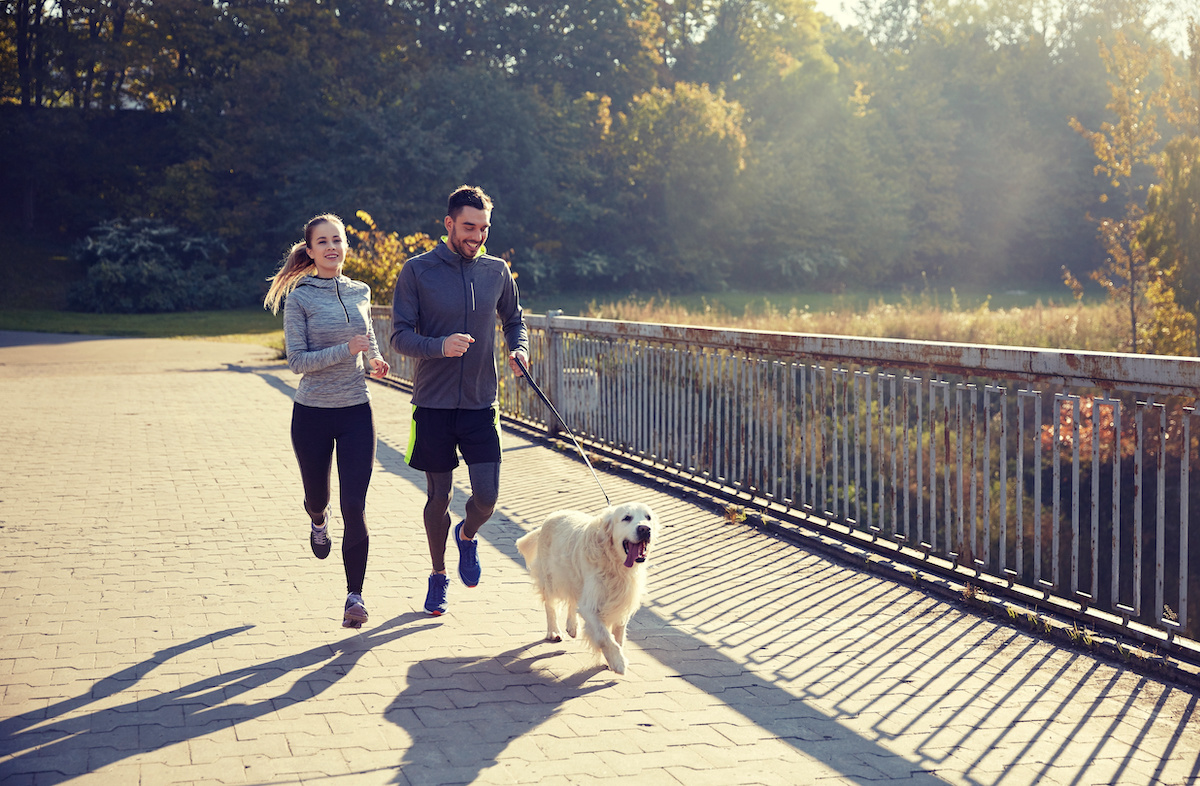Running with your dog combines exercise, adventure, and bonding with your pet in a way that’s beneficial for both your health and that of your furry companion. But this activity isn’t as simple as just putting a leash on your dog and heading out the door. The process requires preparation and consideration to ensure a safe and enjoyable experience for all!
If you’re looking to take your pet along on your jogs, here’s how you can make running with your dog an enjoyable part of your fitness routine.
Running with Your Dog: Assess Your Dog’s Health and Fitness
When you begin an exercise program, it’s a good idea to check with your doctor. It’s also a good idea to check in with your dog’s vet before you begin running with your dog.
Just like humans, dogs need to be in good physical condition to handle the exertion of running. Schedule a visit to the veterinarian to confirm your dog is healthy enough for vigorous exercise.
Consider their breed as well; some are naturally better suited for long distances or sprints. Ensure your dog is up-to-date on vaccinations and preventative treatments for fleas, ticks, and heartworms. This is because exposure to the outdoors can increase their risk of contracting parasites.
Build Up Endurance Gradually
With proper training, dogs can run a surprisingly long distance–about 25 miles, which is almost a marathon. However, don’t expect your dog to run this distance on day 1!
Dogs, especially those who aren’t used to regular exercise, need time to build stamina. This is definitely the same process for humans–you also need to start slow if you are not conditioned to running.
How to Begin
Start with short, slow runs, and observe how your dog handles the activity. Gradually increase the distance and pace over several weeks. The idea is to allow your dog to develop the endurance necessary to run longer distances without getting overly fatigued.
Pay attention to your dog’s demeanor and energy levels during and after the run to gauge their comfort and endurance.
Your dog can likely handle running longer distances when you notice the following:
- They are breathing normally and not panting excessively.
- The gums are still pink and moist.
- Not showing any signs of pain or discomfort.
- Eager to run and play.
- They are able to maintain a good pace without slowing down too much.
If you notice any of the following, it is best to stop running and rest your dog:
- Excessive panting.
- Their gums are pale or dry.
- Showing signs of pain or discomfort.
- They are slowing down too much or stopping altogether.
It is important to start slowly and gradually increase the distance you run with your dog to avoid injury. It is also important to make sure your dog drinks water and has plenty of rest before and after running.
Invest in Appropriate Gear
Investing in the right gear is crucial for a safe and effective run. A sturdy, adjustable harness is preferable over a collar as it provides control without putting pressure on your dog’s neck. A leash that can absorb shocks will make the run more comfortable for both you and your pet.
Furthermore, consider reflective gear for early morning or evening runs. Always have water and a portable bowl to prevent dehydration. You can carry this along in a bookbag or invest in a camelback pack that holds up to 2 L of water.
Master Proper Leash Etiquette
Training your dog for proper leash manners is necessary for safety and enjoyment during the run. They should know how to walk calmly by your side without pulling ahead or lagging behind.
One effective way to train on leash etiquette is with positive reinforcement techniques. The goal is to them to run at your pace, and to stop or turn when needed. This level of control is highly important especially in areas with traffic, other animals. When there are any external factors that might excite or distract your dog, you’ll want to practice proper leash etiquette.
Recognize Your Dog’s Limits
Not every dog can withstand long-distance running or high-speed sprints. Factors such as age, breed, health, and even the weather, play a significant role in determining how suitable your furry friend is for running.
Young puppies and older dogs have joint considerations, certain breeds overheat easily, and all dogs need regular breaks. Watch for signs of fatigue or overheating like excessive panting, drooling, or resistance to continue running.
What are the Best Dog Breeds for Running Companions?
The best dog breeds for running companions are those that are energetic, have endurance, and are good off-leash. Some of the best breeds for running include:
- Vizsla: Vizslas are a medium-sized breed that has great speed and endurance. They are also very friendly and affectionate, making them great running companions.
- Weimaraner: Weimaraners are a large breed that also has impressive speed, stamina, and intelligence. They are also very loyal and protective, making them great running companions for runners who want a dog that will keep them safe.
- Border Collie: Border Collies are a medium-sized breed with exceptional intelligence, agility, and energy. These dogs are quite trainable, making them great running companions for runners who want a dog that can keep up with them on long runs.
- Labrador Retriever: Labrador Retrievers have friendly, outgoing personalities and a great love of people. Labs are very intelligent and easy to train, making them great running companions for runners of all levels.
- Golden Retriever: Golden Retrievers are similar to Labrador Retrievers in terms of personality and trainability. They are also very active and love to run, making them great running companions for runners who want a dog that will keep them company on long runs.
- Australian Shepherd: Australian Shepherds are highly intelligent, agile, and a lot of energy. They are also very trainable, making them great running companions for runners who want a dog that can keep up with them on long runs.
It is important to choose a dog that is the right fit for your lifestyle and running habits. If you are unsure about your dog’s ability to run long distances, please call us at Animal Care Center.
Stay Mindful of the Weather and Terrain
Dogs handle temperature differently than humans do. Hot weather can lead to overheating and burnt paws on hot pavement, while cold temperatures may require protective gear for some breeds.
Meanwhile, choose running times when the temperature is moderate, and be mindful of the running surface. Soft trails are easier on your dog’s joints and paws than asphalt or concrete. Always check your dog’s paws after a run for any indication of injury or burn from the pavement.
Running with Your Dog: Get Your Pup a Checkup at Animal Care Center
Ready to go running with your best friend? Get your pup a checkup at Animal Care Center before you start running! Please call us today to schedule an appointment.







